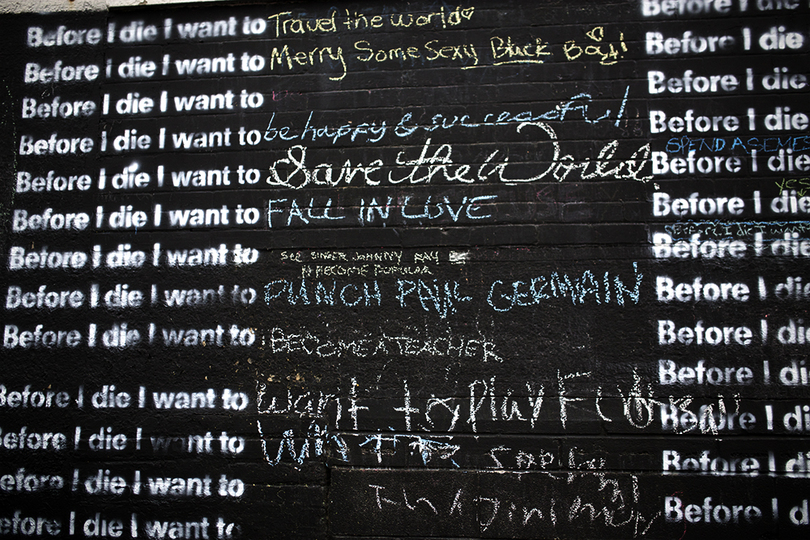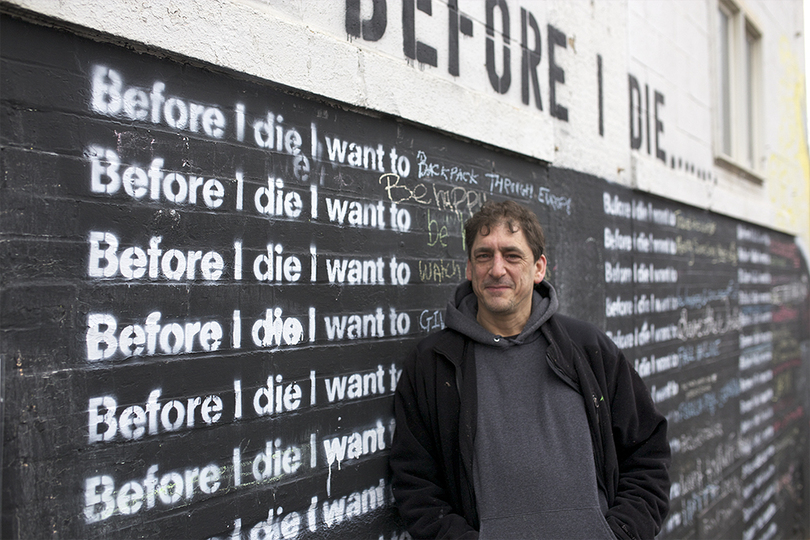Death wish: Artist installs bucket list wall to inspire Syracuse residents to share goals, dreams
A building owner in Syracuse accomplished one of the goals on his bucket list when he made a wall that helps others realize the goals on theirs.
The wall was simple in concept: take the side of an abandoned building, a construction site or even a piece of plywood, paint it with chalkboard paint, stencil on the sentence “Before I die I want to…” and wait for the responses to start rolling in.
In October, the “Before I Die” wall came to Syracuse when Rick Destito, the owner of The Gear Factory, a creative hub for artists, created it at the site of the building’s renovation. The wall is continuing to expand, as wishful thinkers stop by the artistic construction every day to leave their goals and dreams on display. Currently, the wall already has more than 100 statements written across it.
The art trend started in New Orleans after the artist Candy Chang lost someone very close to her and was sent into a long period of grief and reflection, which prompted her to create the wall, according to her website. Since it began, there have been 400 walls in 60 countries, including South Africa, Mexico, Portugal and Argentina.
Destito brought the trend to his space because he believes in the potential of Syracuse residents, according to The Gear Factory’s page on the “Before I Die” website. Charlie Sam, an artist affiliated with the project, assisted in painting the wall and said the project has maintained momentum.
“The impact already has resulted in thousands of people coming in and writing on the wall their ambitions, hopes and dreams and that is something the wall is making happen all over the world,” Sam said.
The wall is hosted by the Gear Factory, a space for artists to practice art education, rehearse, find books or create, making it a compatible location with the “Before I Die” movement, Sam said. He added that the building was known for its artistic endeavors, referring to it as the “cradle of invention” back in its heyday around the turn of the century.
Destito said the wall is part of a mission to revitalize the city so that it is more “walkable” and captivating for residents, according to The Post-Standard.
Laura Audriey Hedglon, a practical nurse and teaching artist, has also been able to see the benefits of The Gear Factory. Hedglon and several patients she works with have been able to use the space as a creative outlet that is not only fun but also supports his communicative needs.
“[The wall] is one big revolving art show of people’s souls. ‘Before I Die’: that’s a big question. That is bigger than most questions you can ask,” she said. “The participatory part of the wall – that is the big deal. Anybody can walk by and go ‘that’s cool art’ but when do they get to be the artist and be part of a huge group of artists?”
Like in Syracuse, the original wall in New Orleans quickly gained popularity. Just one day after its creation, the wall was completely covered with residents’ contributions. The wall reminded Chang that she was not alone in the confusing journey of life, she wrote on her website.
After receiving hundreds of responses from inspired people who wanted to make their own wall, Chang decided to create a website and toolkit for the project that gave instructions on constructing the wall.
Today, the wall has reached another medium. There is now a “Before I Die” book, which contains a compilation of the campaign’s walls across the globe.
As with Chang’s original, The Gear Factory’s “Before I Die” wall has proven to be an outlet for the people of Syracuse, allowing them to express their desires. Writing them down in a public space gives residents of Syracuse a piece of architecture that represents the city’s aspirations.
Assistant Photo Editor Margaret Lin contributed reporting to this story.
Published on January 15, 2014 at 1:40 am
Contact Mandisa: meshield@syr.edu








